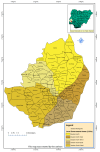Factors associated with caregivers' food safety knowledge, behavior, perception of food safety control, and the nutrition status of under-5 children in Nigeria
- PMID: 39402544
- PMCID: PMC11472490
- DOI: 10.1186/s12889-024-20183-8
Factors associated with caregivers' food safety knowledge, behavior, perception of food safety control, and the nutrition status of under-5 children in Nigeria
Erratum in
-
Correction: factors associated with caregivers' food safety knowledge, behavior, perception of food safety control, and the nutrition status of under-5 children in Nigeria.BMC Public Health. 2024 Nov 20;24(1):3223. doi: 10.1186/s12889-024-20661-z. BMC Public Health. 2024. PMID: 39567967 Free PMC article. No abstract available.
Abstract
Background: Household-level food safety practices may have a long-term outcome on the nutrition and health status of under-five children. This study explores the relationships between caregivers' self-reported food safety knowledge, behavior, perception of food safety control, and their young child's (< 5 years) nutrition status.
Methods: In a cross-sectional study design, 664 caregivers from five Local Government Areas (LGAs) in Ibadan, Nigeria were surveyed using an interviewer-administered questionnaire on their food safety knowledge, behavior and perceived food safety control. Anthropometric measurements of the household's index child (aged 6-59 months) were also taken. Variables for food safety knowledge and behavior score were selected using principal component analyses. The nutritional status of the children (Z-scores for weight-for-height (WAZ), height-for-age (HAZ), and weight-for-age (WHZ)) were calculated. Description statistics were run on all variables and logistic regression models examined associations between the three food safety constructs and the children's nutritional status. Covariates such as LGAs, caregiver's age, household size, wealth index, child's gender, and age were adjusted.
Results: High-level of food safety knowledge, behavior and lots of perceived control on food safety issues were reported by 77.7%, 76.7%, and 81.1% of the caregivers. Using WAZ, HAZ and WHZ that are ≤ -2, acute malnutrition (6.0%), chronic malnutrition (42.5%), and underweight (22.0%), respectively were prevalent among the children. Perceived food safety control was the only food safety construct associated with acute malnutrition. Wealth index, caregivers' age, number of under 5 at home, child age, and gender were associated with acute malnutrition. Caregiver's age, child's age, and gender were associated with chronic malnutrition. Furthermore, caregiver's age, education and child's age were associated with a child being underweight. The significance level was at P < 0.05.
Conclusion: Factors associated with food safety and children's nutritional outcomes are multi-faceted in nature. Future studies should explore access to resources and other intermediate factors that may explain the linkage between childhood malnutrition and caregivers' food safety awareness, knowledge, and behavior. Public health and food safety initiatives to bridge the gap between perceived food safety control and actual food safety behavior/practices.
Keywords: Childhood malnutrition; Food safety behavior; Food safety knowledge; Perception of food safety control.
© 2024. The Author(s).
Conflict of interest statement
The authors declare no competing interests.
Similar articles
-
Nutritional status of primary school children and their caregiver's knowledge on malnutrition in rural and urban communities of Ekiti State, Southwest Nigeria.PLoS One. 2024 May 13;19(5):e0303492. doi: 10.1371/journal.pone.0303492. eCollection 2024. PLoS One. 2024. PMID: 38739629 Free PMC article.
-
Determinants of Child Malnutrition and Infant and Young Child Feeding Approaches in Cambodia.World Rev Nutr Diet. 2016;115:61-7. doi: 10.1159/000444609. Epub 2016 May 19. World Rev Nutr Diet. 2016. PMID: 27197522 Review.
-
Relationship between caregivers' nutritional knowledge and children's dietary behavior in Chinese rural areas.Zhong Nan Da Xue Xue Bao Yi Xue Ban. 2012 Nov;37(11):1097-103. doi: 10.3969/j.issn.1672-7347.2012.11.003. Zhong Nan Da Xue Xue Bao Yi Xue Ban. 2012. PMID: 23202628
-
Exploring the determinants of malnutrition in 2-5 year Iranian children using structural equation modeling: national food and nutrition surveillance.BMC Public Health. 2024 Dec 18;24(1):3406. doi: 10.1186/s12889-024-20931-w. BMC Public Health. 2024. PMID: 39696079 Free PMC article.
-
A Review of Selected Studies on the Factors Associated with the Nutrition Status of Children Under the Age of Five Years in South Africa.Int J Environ Res Public Health. 2020 Oct 30;17(21):7973. doi: 10.3390/ijerph17217973. Int J Environ Res Public Health. 2020. PMID: 33142965 Free PMC article. Review.
References
-
- World Health Organization. Estimating the Burden of foodborne diseases. Available: https://www.who.int/activities/estimating-the-burden-of-foodborne-diseases. Accessed: Nov. 07, 2023.
-
- Centers for Disease Control and, Prevention. CDC’s role in food safety. Available: Centers for Disease Control and Prevention. Accessed: Nov. 07, 2023.
-
- Jaffee S, Henson S, Unnevehr L, Grace D, Cassou E. The status of food safety management in developing countries. in The safe food imperative: Accelerating progress in low- and middle-income countries, in agriculture and rural development. The World Bank; 2018. pp. 69–122. 10.1596/978-1-4648-1345-0_ch3.
-
- Food, Administration D. People at risk of foodborne illness. Available: https://www.fda.gov/food/consumers/people-risk-foodborne-illness. Accessed: Nov. 07, 2023.
Publication types
MeSH terms
LinkOut - more resources
Full Text Sources
Medical
Miscellaneous


